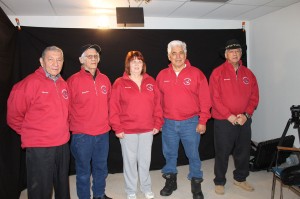Maliseet Language Project

When we lose the language of any cultural group we lose a piece of living history, and we lose the story of those people.
Many cultures are now taking steps to preserve the language spoken by their ancestors, before it is too late, such as with the Welsh and other ancient Celtic languages in the UK, and now at Tobique First Nation.
Only a generation or two ago the Maliseet language was still being spoken in most native homes at Tobique First Nation, in spite of concerted efforts by the Canadian government to eradicate it.
But, as the Elders who spoke the language passed on, there were no new Maliseet speakers to take their place, and so the language was slowly but surely dying out.
Two years ago, Stewart Paul, who was then Chief at Tobique, realized that the spoken Maliseet language would soon be lost unless steps were taken immediately.
Maliseet has always been oral. It was never written down until just recently, when it began to be recorded phonetically. However, you cannot learn the language from a book, you have to hear it spoken if you want to know the true sound of it.
Some of our historical lost languages were written down, recorded on clay tablets or papyrus and the words have been deciphered, but no one knows how the spoken language sounded. There have been close to half a million clay codexes recovered from the ancient civilization of Sumeria, which is in what is now Iraq.
These clay tablet tell an amazing history in a written dialect called “cuneiform.” Scholars have deciphered what many of the symbols and words mean, but no one living knows what the language sounded like.
So even though Maliseet can now be written, only by hearing it spoken will you know how it sounds.
And there certainly aren’t any world famous Berlitz Language Tapes in Maliseet available!
In fact, Stewart’s own mother had learned Maliseet by total immersion in the language and culture. She was an English War Bride, who married Stewart’s father and immigrated to Canada after WW II.
The couple lived with Stewart’s grandparents, who did not speak English at all. Stewart’s grandmother taught her new English daughter-in-law the Maliseet language by pointing to an object and saying what it was in Maliseet.
Stewart’s mother learned the language through sound and gesture.
She was the first woman of another culture to live at Tobique First Nation and learn the language.

Ron and Shirley are providing technical assistance as Bob and Ian of AMW produce the latest Maliseet Project Film
Two years ago, AMW founder Bob Miller, along with his son Ian, came to TFN to begin filming the documentaries that would record and preserve the Maliseet language.
A film was made at that time of Maliseet Elders telling stories in their native language, with English sub-titles at the bottom of the screen.
A number of TFN residents were drafted as technical help and support to help create this first film. As they learned how to operate the cameras and recording equipment they wanted to learn more about film making. Three people from this original project went on to attend the New Brunswick School of Craft and Design to become professional film makers.
The language lesson and documentary that AMW is currently filming is going to be modelled after the Sesame Street method to make it easier for watchers to learn the language. That is, rather than stories being told with subtitles as in the first film, the Native speakers will say the names of objects so watchers can learn what everyday utensils and situations are called in Maliseet.
Stephanie Kelley
